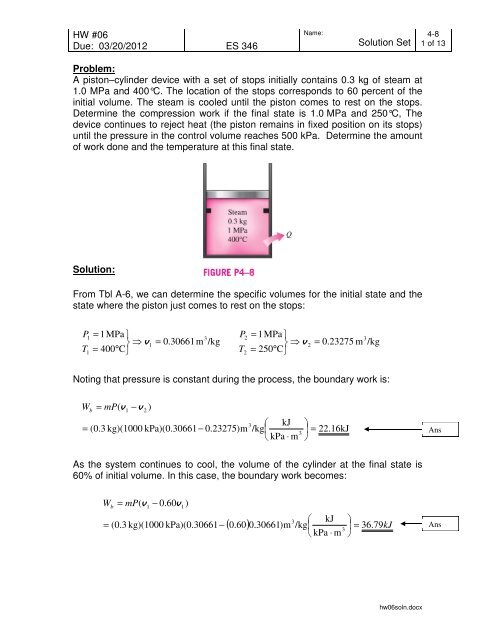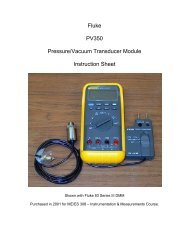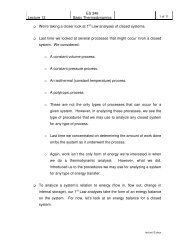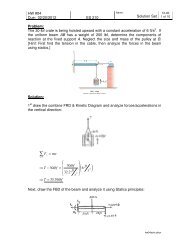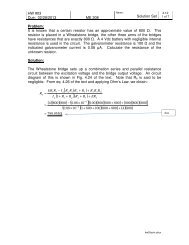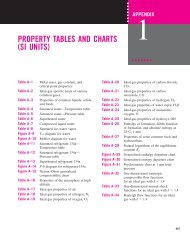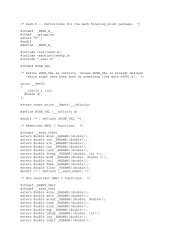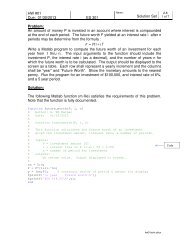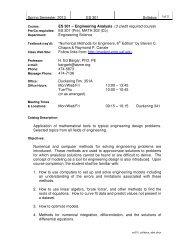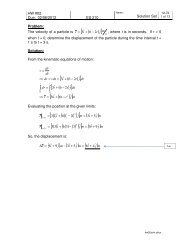HW #06 Solution - for H. Ed Bargar, PhD, PE
HW #06 Solution - for H. Ed Bargar, PhD, PE
HW #06 Solution - for H. Ed Bargar, PhD, PE
- No tags were found...
You also want an ePaper? Increase the reach of your titles
YUMPU automatically turns print PDFs into web optimized ePapers that Google loves.
<strong>HW</strong> <strong>#06</strong>Due: 03/20/2012 ES 346Name:<strong>Solution</strong> Set4-81 of 13Problem:A piston–cylinder device with a set of stops initially contains 0.3 kg of steam at1.0 MPa and 400°C. The location of the stops corresponds to 60 percent of theinitial volume. The steam is cooled until the piston comes to rest on the stops.Determine the compression work if the final state is 1.0 MPa and 250°C, Thedevice continues to reject heat (the piston remains in fixed position on its stops)until the pressure in the control volume reaches 500 kPa. Determine the amountof work done and the temperature at this final state.<strong>Solution</strong>:From Tbl A-6, we can determine the specific volumes <strong>for</strong> the initial state and thestate where the piston just comes to rest on the stops:P1= MPa ⎫⎬ ⇒ v1= 0.30661m /kgT1= 400°C⎭1 P323T2= 1MPa ⎫⎬ ⇒ v2= 250°C⎭= 0.23275 m/kgNoting that pressure is constant during the process, the boundary work is:W b= mP(v −v)123 ⎛ kJ= (0.3 kg)(1000 kPa)(0.30661−0.23275)m /kg⎜⎝ kPa ⋅ m3⎞⎟⎠= 22.16kJAnsAs the system continues to cool, the volume of the cylinder at the final state is60% of initial volume. In this case, the boundary work becomes:W b= mP(v1− 0.60v1)⎛ kJ ⎞= (0.3 kg)(1000 kPa)(0.30661−⎜793⎟⎝ kPa ⋅ m ⎠3( 0.60) 0.30661)m /kg = 36. kJAnshw06soln.docx
<strong>HW</strong> <strong>#06</strong>Due: 03/20/2012 ES 346Name:<strong>Solution</strong> Set4-82 of 13We can find the temperature at this state by interpolating in Tbl A-5:Pv22= 0.5 MPa ⎫⎬ ⇒ T32= ( 0.60)0.30661m /kg⎭= 151.8°CAnshw06soln.docx
<strong>HW</strong> <strong>#06</strong>Due: 03/20/2012 ES 346Name:<strong>Solution</strong> Set4-133 of 13Problem:1-m 3 of saturated liquid water at 200°C is expanded isothermally in a closedsystem until its quality is 80 percent. Determine the total work produced by thisexpansion, in kJ.<strong>Solution</strong>:Assume that the process is quasi-equilibrium.From Tbl A-4:P = P1v = v122= Pf @ 200°Cv = v + xfsat @ 200°C= 0.10200 m( v − v )= 0.001157 m= 0.001157 mg33f+ 0.80(0.12721−0.001157)kgmkg= 1554.9 kPa3kg3kgFrom the definition of specific volume:vV = V30.10200 mkg= (1 m )=0.001157kg2332 188.16 m3v1mThere<strong>for</strong>e, the work done during the process is:23⎛1kJ ⎞3W b , out= ∫ Pd = P( V2−V1)= (1554.9 kPa)(88.16 −1)m⎜ = 135.5×10 kJ13⎟⎝1kPa⋅ m ⎠V AnsP(kPa)15551 21 88.16V (m 3 )hw06soln.docx
<strong>HW</strong> <strong>#06</strong>Due: 03/20/2012 ES 346Name:<strong>Solution</strong> Set4-294 of 13Problem:A closed system like that shown in Fig. P4–29E is operated in an adiabaticmanner. First, 15,000 lbf·ft of work are done by this system. Then, work isapplied to the stirring device to raise the internal energy of the fluid by 10.28 Btu.Calculate the net increase in the internal energy of this system.<strong>Solution</strong>:Assume that the system is stationary and thus the kinetic and potential energychanges are zero. Also, assume that there are no work interactions involved andthat the thermal energy stored in the cylinder itself is negligible.This is a closed system since no mass enters or leaves. The energy balance <strong>for</strong>this stationary, closed system is:Ein out14243Net energy transferby heat, work, and massW− Ein−Wout=Change in internal, kinetic,potential, etc.energies= ∆U∆Esystem14243(since KE = <strong>PE</strong> = 0)The problem statement gives:andWin= 10.28 BtuW1Btu= (15,000 lbf ⋅ ft)778.17 lbf ⋅ ftout=19.28 BtuSubstituting into the energy balance:∆ U = W −W= 10.28Btu−19.28Btu= − 9. 00BtuAnsinouthw06soln.docx
<strong>HW</strong> <strong>#06</strong>Due: 03/20/2012 ES 346Name:<strong>Solution</strong> Set4-365 of 13Problem:A fixed mass of saturated water vapor at 300 kPa is isothermally cooled until it isa saturated liquid. Calculate the amount of heat rejected during this process, inkJ/kg.<strong>Solution</strong>:Assume that the cylinder is stationary and thus the kinetic and potential energychanges are zero. Also, assume that there are no work interactions involvedother than the boundary work and that the thermal energy stored in the cylinderitself is negligible. Finally, assume that the compression or expansion process isquasi-equilibrium.Consider the contents of the cylinder to be the system. This is a closed systemsince no mass enters or leaves. The energy balance <strong>for</strong> this stationary, closedsystem can be expressed as:Ein out14243Net energy transferby heat, work, and mass− Qout− E−Wb,out− Q− QQqoutoutoutout=Change in internal, kinetic,potential, etc. energies= ∆U= m(u= WTb,out= m(h12= m(h1= h − h∆Esystem14243− h )212)2+ m(u− h− u21)− u1)(since KE = <strong>PE</strong> = 0)The process can be shown on a T-V Diagram as follows:2 1From the energy balance:vq= h− h= hout g f fg @ 300 kPa= 2163. 5kJkgAnsFrom Tbl A-5.hw06soln.docx
<strong>HW</strong> <strong>#06</strong>Due: 03/20/2012 ES 346Name:<strong>Solution</strong> Set4-366 of 13Note that the temperature also remains constant during the process and it is thesaturation temperature at 300 kPa, which is 133.5°C.hw06soln.docx
<strong>HW</strong> <strong>#06</strong>Due: 03/20/2012 ES 346Name:<strong>Solution</strong> Set4-387 of 13Problem:An insulated piston–cylinder device contains 5 L of saturated liquid water at aconstant pressure of 175 kPa. Water is stirred by a paddle wheel while a currentof 8 A flows <strong>for</strong> 45 min through a resistor placed in the water. If one-half of theliquid is evaporated during this constant-pressure process and the paddle-wheelwork amounts to 400 kJ, determine the voltage of the source. Also, show theprocess on a P-v diagram with respect to saturation lines. (Note: electrical powerequals volts X amps.)<strong>Solution</strong>:Assume that the cylinder is stationary and thus the kinetic and potential energychanges are zero. Assume that the cylinder is well-insulated and thus heattransfer is negligible. Assume that the thermal energy stored in the cylinder itselfis negligible. Finally, assume that the compression or expansion process isquasi-equilibrium.Consider the contents of the cylinder to be the system. This is a closed systemsince no mass enters or leaves. The energy balance <strong>for</strong> this stationary, closedsystem can be expressed as:We,inin out14243Net energy transferby heat, work, and mass+ WEWpw,ine,in− E−W+ W( VI∆t)+ Wb,outpw,inpw,in=Change in internal, kinetic,potential, etc. energies= ∆U= m(h2= m(h∆Esystem142432(since Q = KE = <strong>PE</strong> = 0)− h )1− h )1The conversion of the r.h.s of the above equation from terms of internalenergy to enthalpy follows <strong>for</strong>m the definition of enthalpy:∆U + W b = ∆Hhw06soln.docx
<strong>HW</strong> <strong>#06</strong>Due: 03/20/2012 ES 346Name:<strong>Solution</strong> Set4-388 of 13The process can be shown on a P-v process diagram as follows:P1 2From Tbl A-4 thru A-6, we can determine the properties of the water at the twostates to be:vP487.01 kJ/kg1= 175 kPa ⎫ h1= hf=⎬ ⇒3sat.liquid ⎭ v1= vf= 0.001057 m /kgP2= 175 kPa ⎫⎬⇒h2= hf+ x2hfg= 487.01+x2= 0.5 ⎭( 0.5)( 2213.1)= 1593.6 kJ/kgV10.005 mm = =v 0.001057 m133/kg= 4.731 kgSubstituting into the above energy balance equation:VI∆t+ (400kJ) = (4.731 kg)(1593.6 − 487.01)kJ/kgVI∆t= 4835 kJ4835 kJ ⎛VA⎞⎛1000W ⎞⇒ V =⎜ ⎟ = 223.8V60sW⎜1 kJ/s⎟⎛ ⎞(8 A) ( 45min)⎝ ⎠⎜ ⎟⎝ ⎠⎝ min ⎠Anshw06soln.docx
<strong>HW</strong> <strong>#06</strong>Due: 03/20/2012 ES 346Name:<strong>Solution</strong> Set4-4510 of 13The electrical power and the enthalpy of vaporization of R-134a are:hW&= VI = (10 V)(2 A) = 20 We,infg @ −5°C= 202.34 kJ/kg (Table A -11)Substituting into the energy balance:(0.020 kJ/s) ∆t= (2 kg)(202.34 kJ/kg)⇒ ∆t= 8093 s = 2.248hrAnsThe temperature remains constant (see T-V Diag.) during this phase changeprocess:T = T = − 5°C21Anshw06soln.docx
<strong>HW</strong> <strong>#06</strong>Due: 03/20/2012 ES 346Name:<strong>Solution</strong> Set4-6911 of 13Problem:A student living in a 4-m X 6-m X 6-m dormitory room turns on her 150-W fanbe<strong>for</strong>e she leaves the room on a summer day, hoping that the room will be coolerwhen she comes back in the evening. Assuming all the doors and windows aretightly closed and disregarding any heat transfer through the walls and thewindows, determine the temperature in the room when she comes back 10 hlater. Use specific heat values at room temperature, and assume the room to beat 100 kPa and 15°C in the morning when she leaves.<strong>Solution</strong>:Assume that air is an ideal gas since it is at a high temperature and low pressurerelative to its critical point values of -141°C and 3.77 MPa. Assume that thekinetic and potential energy changes are negligible,From Tbl A-1 & A-2:R = 0.287 kPa.m 3 /kg.Kc v = 0.718 kJ/kg.KTake the room as the system. This is a closed system since the doors and thewindows are said to be tightly closed, and thus no mass crosses the systemboundary during the process. The energy balance <strong>for</strong> this system can beexpressed as:Ein− Eout14243Net energy transferby heat, work, and massWWe,ine,in=Change in internal, kinetic,potential, etc.energies= ∆U∆Esystem14243= m( u2− u1)≅ mc ( T2− T1)vhw06soln.docx
<strong>HW</strong> <strong>#06</strong>Due: 03/20/2012 ES 346Name:<strong>Solution</strong> Set4-6912 of 13The mass of air is:V = 4m× 6m× 6m= 144 m3m =3P1V (100 kPa)(144 m )=RT31⎜⎛0.287kPa ⋅ m ⎟⎞(288 K)⎝kg ⋅ K ⎠= 174.2 kgThe electrical work done by the fan is:WekJ ⎛ 3600s ⎞= W&⎛0.15⎞e∆t= ⎜ (10hr) = 5400kJs ⎟ ⎜ ⎟⎝ ⎠ ⎝ hr ⎠Substituting and using the c v value at room temperature:5400kJ=⇒ T2( 174.2kg) 0.718kJ( T −15)= 58.17°C⎜⎛⎝kg C⎟⎞⋅° ⎠2° CAnsNote that a fan actually causes the internal temperature of a confined space torise. In fact, a 100-W fan supplies a room with as much energy as a 100-Wresistance heater.hw06soln.docx
<strong>HW</strong> <strong>#06</strong>Due: 03/20/2012 ES 346Name:<strong>Solution</strong> Set4-7213 of 13Problem:A piston–cylinder device containing argon gas as the system undergoes anisothermal process from 200 kPa and 100°C to 50 kPa. During the process, 1500kJ of heat is transferred to the system. Determine the mass of this system andthe amount of work produced.<strong>Solution</strong>:Assume that Argon is an ideal gas since it is at a high temperature and lowpressure relative to its critical point values of 151 K and 4.86 MPa. Also, assumethat the kinetic and potential energy changes are negligible, ke ≅ ∆pe≅ 0∆ .From Tbl A-1: R = 0.2081kJ/kg⋅KTake the argon enclosed in the device as the system. This is a closed systemsince no mass crosses the boundaries of the system. The energy balance <strong>for</strong>this system can be expressed as:EThere<strong>for</strong>e:in out14243Net energy transferby heat, work, and massQQinin− E−W−Wb,outb,outQin=Change in internal, kinetic,potential, etc.energies= ∆U= mc ( T= 0= Wb,out∆Esystem14243v(since T12− T )= T21)Argon200 kPa100°CQW b= Q 1500kJ, out in=AnsUsing the boundary work relation <strong>for</strong> the isothermal process of an ideal gas:22dv2W b , out= m∫ Pdv= mRT∫= mRT ln = mRT lnv v11 1vP1P2Solving <strong>for</strong> the mas:m =Wb,outP1RT lnP2=⎜⎛0.2081 kPa ⋅ m⎝31500 kJ200 kPa(100 273)Klnkg K⎟⎞ +⋅ ⎠50 kPa= 13.94kgAnshw06soln.docx


